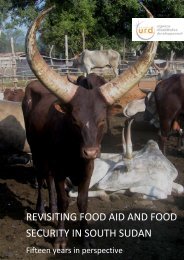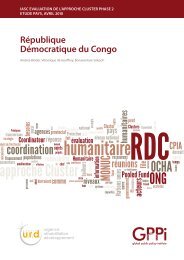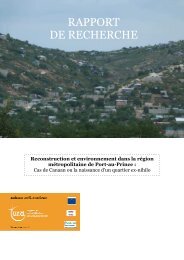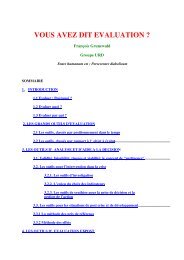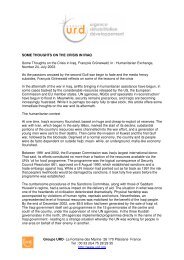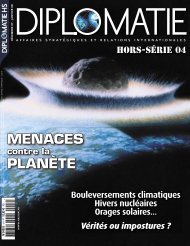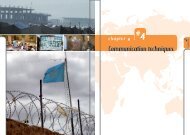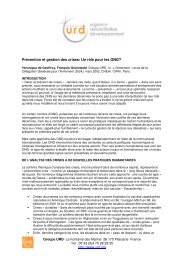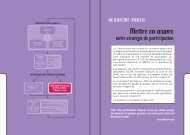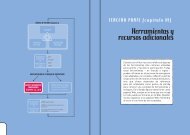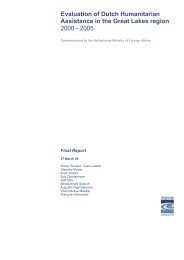Kabul Urban Survey - Groupe URD
Kabul Urban Survey - Groupe URD
Kabul Urban Survey - Groupe URD
You also want an ePaper? Increase the reach of your titles
YUMPU automatically turns print PDFs into web optimized ePapers that Google loves.
the Government of Afghanistan. The aim is to extend this work on a national scale but<br />
it will take a considerable amount of time to complete this.<br />
5.2 Observations on spatial data<br />
5.2.1 Outdated spatial reference<br />
In conclusion, for analysing, working, programming, tackling urban issues and implementing<br />
urban programmes, the different urban actors do not have many maps of <strong>Kabul</strong> city at their<br />
disposal.<br />
- Two out-of-date plans used as administrative references by <strong>Kabul</strong> Municipality: the<br />
Master Plan of <strong>Kabul</strong> 1978 and the <strong>Kabul</strong> Map with 22 districts which is currently in use.<br />
- Different departments in the MoUD use different data.<br />
- The international community involved in the urban sector use satellite maps or AIMS<br />
2005 plans.<br />
5.2.2 Steps in providing training on spatial representation<br />
The different administrative departments have received some computer training but a lot of<br />
time is required before they are operational with computers. For example, AGCHO received<br />
its first computer only three or four years ago and one was reserved for administration.<br />
Participants attending GIS training need to be computer literate. So different approaches<br />
could be adopted to improve efficiency in GIS:<br />
- Various levels of training. This process has already begun with AIMS and EMG/USAID<br />
training sessions which provide various levels of training programmes. This will take<br />
longer than with a normal training session because many of the engineers are middleaged<br />
and were trained in the 1970s under the Soviet occupation. Learning new<br />
techniques will take time.<br />
- Mixed classes of professional engineers and students in the medium term.<br />
Providing training to both AGCHO engineers and students from technologic engineering<br />
university departments could be a means of accelerating the exchange of practical<br />
experience and training the new generation in GIS. The time required to master these<br />
skills is estimated at between two and four years.<br />
- Budget to pay competent engineers in the present term. In order to benefit from<br />
international and modern technical assistance with Afghan or foreign engineers, it is<br />
important that all engineers in the GIS map departments are capable of working with<br />
computer software.<br />
5.2.3 Accelerate spatial expertise in parallel<br />
Updating existing city maps and creating new spatial graphic information at different levels is<br />
urgently required in order to build a database of the real urban situation and to be able to<br />
coordinate forthcoming rehabilitation or extension programmes. Establishing a consensus<br />
between all the different urban stakeholders on urban maps is necessary in order to resolve<br />
urban issue collectively. An acceleration in the process with the support of external expertise<br />
could allow international aid organisms to target programmes more quickly towards locally<br />
affected populations and needs.<br />
5.3 Actors involved in urban planning: process & problems<br />
5.3.1 Multiplicity of actors and data sources<br />
In the period of institutional reconstruction, the roles of local traditional institutions,<br />
international aid organisations, funding partners, UN advisors and NGOs are unclear. Each<br />
actor has its own objectives and ideas on the subject of rehabilitation but coordination needs<br />
to be established between:<br />
Page 53



